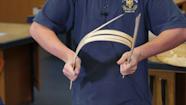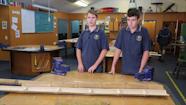Steve Andrew describes how his senior students have the confidence to select and work with unfamiliar materials.
Pushing the boundaries with materials
Transcript
Between year 9 and year 11, we try to introduce our students to as many different materials as we can. I think the units of work that we cover allow for that, and by the time we get to year 11, our students have probably worked with aluminium, compressed polystyrene, perspex, plywood, mild steel, stainless steel. And you know, a range of materials like that gives the students a really good base when they’re at senior school to be able to make decisions on materials for their particular projects and it enhances or gives depth to their design as well.
When we get to say year 12, it’s actually I guess at times quite scary because I don’t find that I have limitations on the materials that our students need. Pretty much, they can use the materials they require for their project. Of course there are specifications with that, and some of them are – are they available, can we manipulate them in our school workshop, and are they cost effective?
We, at times, use materials that we’ve never ever touched or got information about before. And whilst that was initially scary, but I think over the years I’ve been able to focus on materials technology, it’s given me the confidence to use the process that we’ve got, or the practice that we use, to successfully learn about those materials and be able to incorporate them in our project.
Because they are all working on individual projects, they have an individual testing plan, and some students will get through that really fast but it’s something that I’ve realised just recently is that it just takes time.
Last year, we started looking at sustainable materials, and we looked at bamboo as a sustainable material for skateboards. And over the last 12 months, our students have developed skateboards that are made of materials that we would not even think about using 10 years ago.
This particular skateboard is made out of bamboo and hessian. We reverse engineered a skateboard and looked at the materials that were in it and then looked to see if we could identify or remove materials that we thought weren’t sustainable. So we replaced things like the plywood, or the American plywoods, with bamboo. We removed the fibreglass matting and replaced it with the hemp and hessian, and this year we are starting to move into looking at sustainable resins, bio-resins, and that sort of stuff.
So I think it’s really important that we’re not scared to do these things. I believe that the curriculum allows us to do that, without our students having issues with assessment and that sort of stuff. I believe if we’re carrying out processes and looking at materials properties like the curriculum asks us to do, then the assessment will come out of that quite comfortably.
Related videos
Combining knowledge and practice (01:58)
Steve Andrew explains how understanding materials is essential for effective technological practice.
Linking hands-on experiences and understandings (03:54)
Hands-on experiences allow the students to see materials understandings in action.
Play, experiment, explore (02:55)
Steve Andrew lets the students see, feel, and play with products to develop their understandings in materials.
Finding materials to meet the specs (02:36)
Steve Andrew shares how students identify material specifications in a brief and then test materials to find those that are suitable....
School–industry relationship cuts both ways (03:36)
Steve Andrew and Terry Rillstone describe the way the relationship between St John's College and The Shop has benefits for them both....
Exploring unfamiliar materials (02:44)
Year 12 students from St John's College describe what they know about bamboo and how they are applying this knowledge to their projects....
Students and teachers talk about testing materials in year 11.
Manipulating, forming, and transforming
Students in year 10 describe manipulating, forming, and transforming materials.
Evaluating materials for an outcome
Steve Andrew and students talk about using their knowledge to test materials for their projects at year 12.
Year 10 students describe some of the attributes for the snake skates they are developing.
Senior students select their own issues
Year 12 students talk about the issues that they have selected for their projects.











